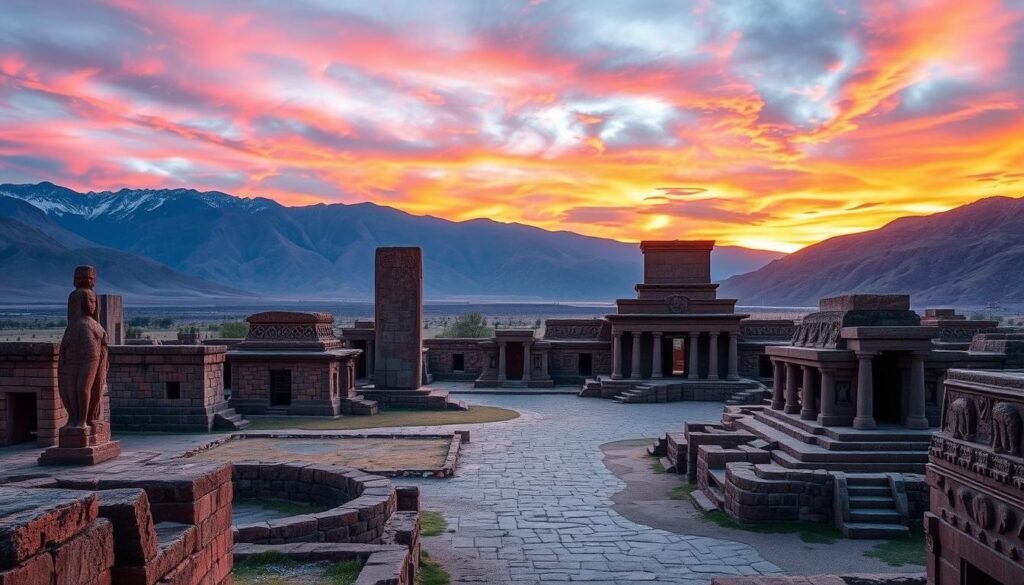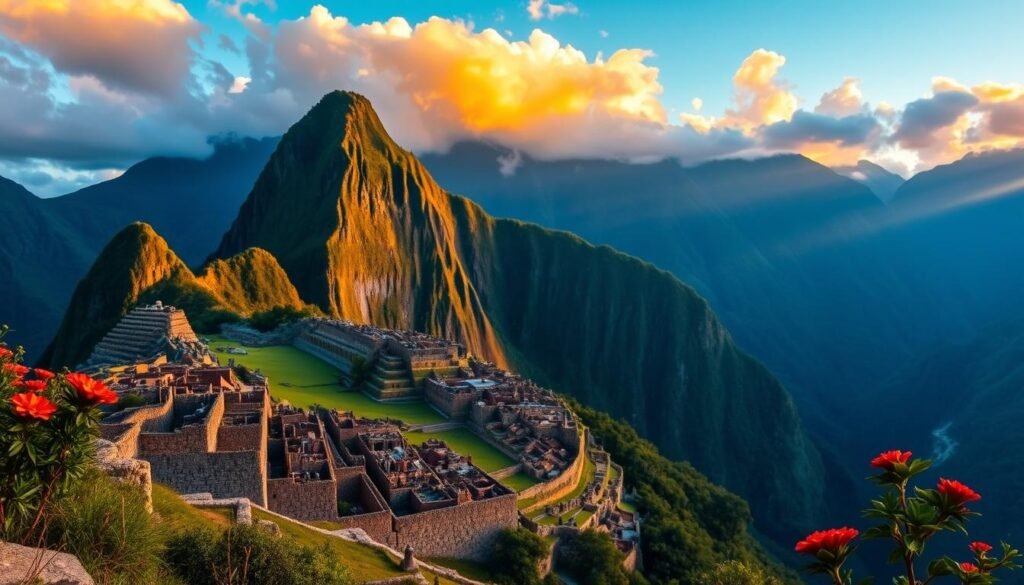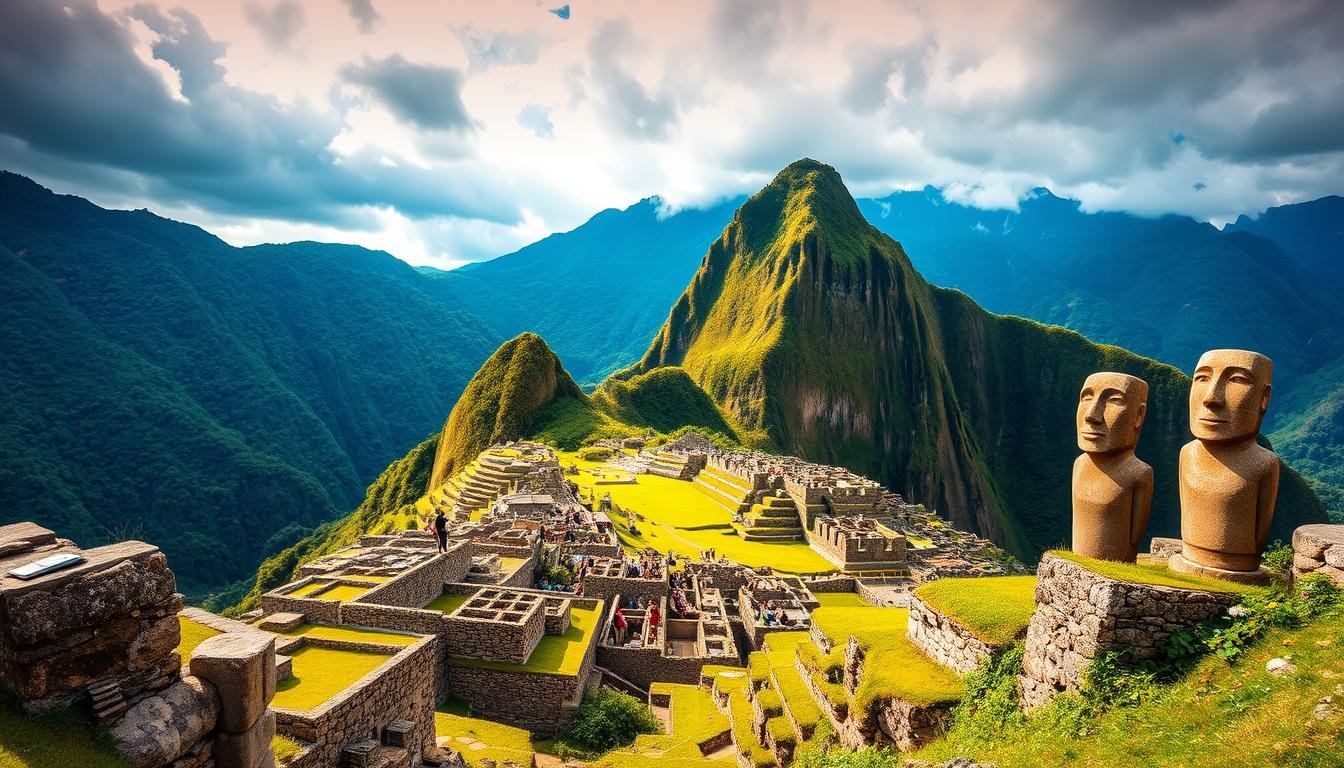Starting your journey to South America’s ancient wonders is exciting. You’ll find a mix of historical sites, landmarks, and cultural heritage. Places like Machu Picchu show the skill of pre-Columbian people. You’ll uncover the secrets of old cultures and see how we protect these sites today.
This guide will help you plan your trip. You’ll learn about the Incan ruins and hidden spots in the Amazon. It’s all about understanding the importance of these ancient sites.
Key Takeaways
- Explore the rich cultural heritage of South America through its ancient wonders
- Discover the history and significance of pre-Columbian civilizations
- Learn about preservation efforts to protect South American heritage sites
- Plan your adventure to iconic sites like Machu Picchu and lesser-known gems in the Amazon Basin
- Appreciate the importance of ancient wonders of South America historical sites landmarks cultural heritage
- Understand the value of responsible tourism in preserving ancient wonders
- Get ready to uncover the secrets of South America’s ancient wonders
Discovering South America’s Rich Archaeological Heritage
South America is home to some of the most remarkable pre-Columbian civilizations landmarks in the world. Exploring these sites offers a glimpse into the continent’s diverse and ancient cultures.
Overview of Pre-Columbian Civilizations
The region was shaped by various civilizations, each contributing uniquely to its history. From the mighty Inca Empire to the lesser-known Moche and Nazca cultures, these societies built impressive structures and developed complex societies.
Timeline of Ancient South American Cultures
Understanding the development of South American cultures involves tracing their timelines:
- Mesoamerican Cultures: Flourished between 2000 BCE and 1500 CE.
- Andean Civilizations: Rise of the Inca Empire around the 13th century.
- Post-Inca Period: Transition and preservation of ancient sites into modern times.
Importance of Preservation Efforts
Maintaining the integrity of Incan ruins South America is crucial for historical and cultural preservation. Ongoing initiatives focus on protecting these landmarks from environmental and human-induced threats. This ensures that future generations can continue to learn from and appreciate these ancient wonders.
Machu Picchu: Crown Jewel of Incan Architecture
Machu Picchu is a marvel of Incan engineering. It sits high in the Andes Mountains. These Incan ruins South America show us a complex society.
In 1911, Hiram Bingham found Machu Picchu. It was probably a palace for the Incan emperor Pachacuti. The city’s design, with its terraces and stonework, is impressive.
- Temple of the Sun: A circular temple used for astronomical observations.
- Intihuatana Stone: A ritual stone associated with astronomical and religious functions.
- Room of the Three Windows: Offers panoramic views and unique architectural features.
Recent studies show Machu Picchu’s importance in Incan astronomy and rituals. It’s best to visit during the dry season. This helps preserve the Incan ruins South America.
| Structure | Description |
|---|---|
| Temple of the Sun | Used for religious ceremonies and astronomical observations. |
| Intihuatana Stone | Ritual stone tied to Incan astronomy and spirituality. |
| Room of the Three Windows | Architecturally significant room offering expansive views. |
Sacred Valley of the Incas: Beyond Machu Picchu
The Sacred Valley of Peru is full of Sacred Valley Peru attractions beyond Machu Picchu. It’s packed with Andean archaeological sites. These sites show the smartness and culture of the Incan people.
Pisac Archaeological Park
Pisac Archaeological Park is famous for its Incan ruins and lively local market. Visitors can see old temples and terraced hills. They also get to see the traditions of the local people.
Ollantaytambo Fortress
The Ollantaytambo Fortress is a big deal in Incan history. Its huge stone terraces and detailed carvings show its importance. It’s a key part of the Incan past.
Moray Agricultural Terraces
Moray Agricultural Terraces show the Incas’ advanced farming skills. These circular terraces were for farming tests. They prove the Incas knew a lot about farming in different places.
Ancient Wonders of South America Historical Sites Landmarks Cultural Heritage
South America is filled with ancient wonders of South America historical sites landmarks cultural heritage. Each site tells a story of ancient civilizations. From Machu Picchu’s towering stones to Nazca’s mysterious lines, these South American heritage sites show the region’s rich history and cultural growth.
These sites show the varied architectural and cultural practices of the past. They share themes like advanced engineering, knowledge of the stars, and detailed craftsmanship. Each landmark is a proof of human creativity and helps us understand ancient South America’s story.
- Machu Picchu: An iconic Incan city nestled in the Andes.
- Chan Chan: The largest pre-Columbian city in South America, located in Peru.
- Tiwanaku: Bolivia’s pre-Incan marvel with impressive stone structures.
Keeping these South American heritage sites safe is a big challenge. Threats like environmental damage and too many tourists are real concerns. It’s important to have sustainable tourism to protect these ancient wonders of South America historical sites landmarks cultural heritage for the future.
| Site | Country | Significance |
|---|---|---|
| Machu Picchu | Peru | Incan architectural masterpiece |
| Chan Chan | Peru | Largest adobe city in the world |
| Tiwanaku | Bolivia | Advanced stonework and ceremonial centers |
| Moray Agricultural Terraces | Peru | Innovative farming techniques |
| Ollantaytambo Fortress | Peru | Strategic military site with intricate stonework |
The Mysterious Nazca Lines of Peru
The Nazca Lines are among the ancient wonders of South America. They attract visitors and researchers to Peru’s desert for decades. These massive geoglyphs are key to understanding the region’s cultural heritage and historical sites landmarks.
Theories Behind Their Creation
Many theories try to explain the Nazca Lines. Some think they were ancient astronomical calendars, matching celestial events. Others believe they were part of religious rituals or pathways for processions.
A few even wonder if aliens were involved, but there’s no solid proof for this.
Best Viewing Perspectives
For the best view, take an aerial tour. It shows the Nazca Lines from above. Or, use elevated platforms for a detailed look without flying.
These views show the lines’ scale and precision. They help you understand their historical significance.
Contemporary Research Findings
Modern tech has changed how we study the Nazca Lines. Drones and AI help find new lines and figures. This deepens our knowledge of these ancient landmarks.
Recent studies look at how they were made and the culture behind them. They offer new insights into their purpose and importance.
| Category | Description | Supporting Evidence |
|---|---|---|
| Astronomical Calendars | Alignment with celestial events. | Positions match solstices and equinoxes. |
| Religious Rituals | Pathways for ceremonial processions. | Proximity to ceremonial centers. |
| Extraterrestrial Theories | Speculation of alien involvement. | Lack of concrete archaeological evidence. |
Tiwanaku: Bolivia’s Pre-Incan Marvel
Tiwanaku is a remarkable site near Lake Titicaca in Bolivia. It’s a UNESCO World Heritage site. It shows the advanced engineering of ancient people.

Exploring Tiwanaku, you’ll see amazing Andean archaeological sites. There’s the Akapana pyramid, the Semi-underground Temple, and the Gateway of the Sun. Each one shows the Tiwanaku culture’s skill in urban planning and architecture.
- Akapana Pyramid: An impressive terraced platform used for ceremonial purposes.
- Semi-underground Temple: A unique structure blending natural and built elements.
- Gateway of the Sun: A finely carved monument central to Tiwanaku’s astronomical observations.
The Tiwanaku people knew a lot about astronomy, agriculture, and planning cities. Their work has influenced many Andean archaeological sites. Research is still uncovering their secrets, showing their achievements in society and technology.
Keeping Tiwanaku safe is a big challenge. People are working hard to protect it from nature and human actions. They want to make sure these ancient wonders are here for the future.
| Structure | Description | Significance |
|---|---|---|
| Akapana Pyramid | Terraced platform used for ceremonies | Demonstrates advanced engineering |
| Semi-underground Temple | Blend of natural and constructed elements | Shows architectural innovation |
| Gateway of the Sun | Finely carved monument | Central to astronomical practices |
Chan Chan: The Largest Pre-Columbian City in South America
Explore Chan Chan, a huge site from pre-Columbian times in South America. It was once the capital of the Chimor Empire. This city shows amazing urban planning and building skills.
Architectural Significance
Chan Chan’s buildings are decorated with detailed friezes and designs. Its water systems and walls show the Chimor’s engineering and defense skills.
Cultural Impact
The Chimor culture thrived in Chan Chan. It was a center for art, trade, and governance. The Inca Empire’s conquest later changed the site’s history.
Preservation Challenges
Keeping Chan Chan safe is hard because of its fragile buildings. Climate change and nearby buildings threaten it. Efforts are being made to protect this important site for the future.
| Feature | Description |
|---|---|
| Location | La Libertad Region, Peru |
| Size | Approximately 20 square kilometers |
| Built By | Chimor Empire |
| Construction Material | Adobe |
| UNESCO Status | World Heritage Site |
Hidden Gems of the Amazon Basin
The Amazon Basin is more than just a huge rainforest. It’s filled with South American heritage sites that show the area’s deep history. These ancient wonders of South America are often missed by tourists.
The Kuélap fortress in Peru is a hidden gem. It’s called the “Machu Picchu of the north.” This place shows the amazing building skills of ancient people.
The Chiribiquete National Park in Colombia is another must-see. Its mysterious rock paintings give us a peek into the spiritual lives of ancient Amazonians.
Exploring the Amazon for archaeology is tough. The thick plants and hard-to-reach places help keep sites untouched. This makes them a treasure trove of history.
Learning about these cultural heritage sites helps us understand the Amazon and Andean cultures. They give us clues about the lives and ways of ancient South Americans.
- Kuélap Fortress, Peru
- Chiribiquete National Park, Colombia
- Geoglyphs of the Brazilian Amazon
| Site | Location | Significance |
|---|---|---|
| Kuélap Fortress | Peru | Incan architecture and strategic location |
| Chiribiquete National Park | Colombia | Ancient rock paintings and biodiversity |
| Geoglyphs of the Brazilian Amazon | Brazil | Pre-Columbian land art and cultural insights |
Essential Tips for Visiting Ancient Sites
Exploring South American heritage sites is a memorable adventure. With the right planning, you can enjoy your visit and respect these ancient wonders.

Best Times to Visit
Think about the weather and local events when you plan your trip.:
- Weather: Go during the dry season for the best weather.
- Crowd Levels: Visit early mornings or weekdays to avoid crowds.
- Festivals: Time your visit with local festivals for a richer experience.
Photography Guidelines
When taking photos, be mindful of the site’s beauty.:
- Restrictions: Some places don’t allow photos in certain areas.
- Respect Preservation: Don’t use flash to protect the ancient structures.
- Best Practices: Use a tripod for stable shots and try different angles for amazing photos.
Cultural Etiquette
Respecting local customs makes your visit better and supports cultural heritage.:
- Appropriate Dress: Wear modest clothes at sacred sites.
- Behavior: Be quiet and don’t touch artifacts.
- Interactions: Learn basic phrases in the local language to communicate respectfully.
Going on guided tours can give you deeper insights. It also helps with language barriers. Supporting local economies by buying authentic crafts helps preserve these incredible sites.
Conservation Challenges and Sustainable Tourism
Keeping South American heritage sites safe is a big challenge. It’s about drawing visitors while keeping ancient wonders safe. We must face many obstacles to make sure these sites are here for the future.
Environmental Threats
Climate change, erosion, and pollution are big dangers. Rising temperatures and weird weather make landmarks wear out faster. Pollution from cities also harms these sites, making it harder to keep them safe.
Community Involvement
Local people are key in saving cultural heritage. They help keep sites in good shape and get jobs from tourism. Their knowledge of the sites’ importance helps make preservation efforts work well.
Responsible Travel Practices
Visitors can help by being mindful of their impact:
- Stay in places that care about the environment.
- Buy things made by local artists.
- Keep your visit green by following site rules.
- Respect local ways of life and traditions.
| Environmental Threat | Preservation Strategy |
|---|---|
| Climate Change | Implement climate-resilient structures and materials. |
| Erosion | Use barriers and restoration techniques to protect sites. |
| Pollution | Regulate nearby activities and enforce pollution controls. |
Modern Technology in Ancient Discovery
Exploring Andean archaeological sites is now easier thanks to new tech. You can find hidden structures that were lost for ages.
LiDAR (Light Detection and Ranging) is a key tool. It maps through dense jungles, showing the layout of old cities. With LiDAR, researchers find new pre-Columbian civilizations landmarks.
Satellite images help find new sites. They show changes in the landscape that hint at human presence. This speeds up finding important sites without needing to search the ground.
Drones change the game for mapping ruins. They give detailed views from above, helping plan digs and preservation. Drones let you check on Andean archaeological sites often and fix problems fast.
New dating and DNA methods give us more info on ancient lives. They show what people ate and where they came from. This helps us understand their culture and how they interacted.
Virtual and augmented reality are changing how we learn. They let you see pre-Columbian civilizations landmarks online. This makes ancient wonders available to all, without needing to travel.
Conclusion: Preserving South America’s Ancient Legacy for Future Generations
Your journey through South America’s ancient wonders shows its rich heritage. It’s key to keep these sites connected to our past.
Keeping these landmarks safe faces many challenges, like environmental threats and urban growth. New ways like green tourism and modern conservation help a lot.
Groups like UNESCO lead the way in protecting South America’s cultural treasures. They work together, sharing skills and resources to care for these sites.
The future looks bright with new trends in archaeology and heritage care. These methods keep sites true to their past while welcoming visitors.
You can help by traveling responsibly, backing conservation efforts, and sharing what you’ve learned. Your efforts keep South America’s ancient wonders alive for future generations.
